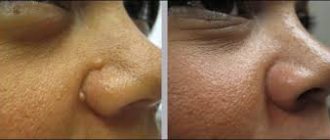Pros and cons of laser papillomas removal
Among the main advantages of laser removal of papillomas over other methods of combating this problem it is worth noting:
- sterility and absence of bleeding during the procedure,
- the papilloma is removed once and never appears again,
- minimal risk of scarring and swelling at the site of laser exposure,
- short duration of the procedure,
- safety and painlessness of the method,
- no damage to the tissue around the papilloma,
- minimal risk of complications,
- short rehabilitation period (no more than 1 week),
- absolute accuracy of the method (the laser beam has a small diameter and is directed directly to the desired location).
In addition, this method of combating papillomas is suitable for absolutely any area of the skin, including intimate areas, sensitive areas of the skin and face. The procedure has no age restrictions, and the risk of side effects is minimal. And you can get rid of several papillomas in one session.
You may be interested in: Laser wart removal
True, there are some disadvantages of using laser:
- There are contraindications to the procedure.
- Complications after laser removal are possible due to improper implementation of the procedure or non-compliance with the doctor’s recommendations by the patient himself.
- Inability to send papilloma for histological examination. That is why, before laser removal, a thorough examination of the patient is performed to exclude the possibility of a malignant nature of this formation.
- The cost of the procedure is quite high.
Innovative surgical laser : the best solution for removing papillomas and other medical procedures.
What are the advantages of laser removal?
Many people prefer cauterization of papillomas with a laser because this is the fastest way to remove them. A high-frequency current is used, causing an increase in tissue temperature, which leads to instant destruction of the skin formation. The procedure is painful, so anesthesia is used. The wounds after cauterization can remain for up to two weeks, after which they disappear. Also, after laser removal of papilloma, hyperpigmentation may occur, but it disappears within 3-6 months. The main advantages of the method include:
- unlike other methods of removing a tumor, a laser makes it possible to control the depth to which it penetrates, as well as calculate the area;
- after the procedure, there is no likelihood of re-formation;
- removal as fast and complete as possible;
- due to the fact that the laser simultaneously cauterizes the tissue and the vessels from which it is supplied, the likelihood of bleeding is eliminated;
- after the procedure there are practically no scars left;
- in just one session you can completely remove the tumor;
- rapid wound healing;
- the method is as safe and sterile as possible;
- Can be used on any part of the body;
- during one procedure, you can remove not just one papilloma with a laser, but several;
- can be used for many diseases.
Using papilloma excision is a more relevant option when it is necessary to check the tissue for the presence of malignant tumors.
Using a laser, you can remove papillomas on the face, which is of interest to many people. Using the presented procedure, you can get rid of the problem in one session; there will be no stain, scar or scar left on your face. No special skin care is required after burning. The wound heals very quickly. Laser can also be used to remove papillomas in intimate places. Often clients come with the desire to remove papillomas on the eyelid, which is also quite possible and safe.
Despite some disadvantages, laser removal allows you to quickly get rid of the problem without negative consequences.
The laser leaves no scars, which is especially important for the face
Indications
As such, there are no exact indications for the removal of papillomas. Usually this procedure is used for aesthetic purposes. But in some cases, laser removal is dictated by the location of the papilloma. For example, in the groin, on the genitals, on the eyelids, armpits, on the neck, since this is where there is a possibility of frequent injury to the formation and, as a result, infection of the damaged area.
Papillomas are small benign growths on the skin caused by the papilloma virus. Most often, they appear against the background of decreased immunity during pregnancy and lactation, in old age, after suffering serious illnesses and stress, and also due to the use of certain medications, such as antibiotics. Externally, papillomas resemble small warts. Their size and color may vary.
It is possible to remove single papillomas and multiple formations located in absolutely any part of your body. The precision of the laser beam will allow minimal impact on the tissues and skin adjacent to the papilloma.
Features of papillomas
Papillomas can be of the following types: ordinary or vulgar warts, filiform (the most common type), flat, genital warts, plantar warts, juvenile warts. A dermatologist diagnoses and treats papillomas.
Most often, papillomas are localized in the armpits and inguinal folds, hands, on the surface of the foot, neck, under the mammary glands in women, as well as on the genitals. Papillomas located on the mucous membranes of internal organs are very dangerous; they can cause ulceration or bleeding. As a rule, papillomas that have a pronounced cosmetic defect are removed with a laser, i.e. which are located in open areas of the body, as well as those with a high risk of cancer.
Contraindications to laser removal of papillomas
Before starting the operation, it is necessary to consult with specialists. Laser removal of papillomas has certain contraindications that must be taken quite seriously.
You may be interested in: General contraindications for laser treatment
Main contraindications:
- Oncological diseases\malignant papilloma. This contraindication is very important and is due to the fact that when removing malignant papillomas, dangerous consequences in the form of skin cancer can occur.
- Skin disorders. Such disorders include: wounds, ulcers and cuts.
- Pregnancy and breastfeeding. During the removal of papillomas for a pregnant woman, there is a high probability that a scar or cicatrice will appear after the procedure. This is due to increased hormonal levels in the body.
- Fresh or heavily tanned skin.
- Increased excitability and diseases of the central nervous system.
- Diseases such as acute respiratory viral infections and acute respiratory infections and any other viral diseases.
- Diabetes mellitus, when the normal functioning of a specific organ or organ system is impaired.
- People under puberty, girls under 18 years of age and women over 45 years of age
Before starting the operation, the doctor must conduct an examination and allow only those patients who have excluded all of the above symptoms and diseases to undergo the procedure.
In each specific case, it is recommended to consult a specialist dermatologist or specialized doctor, for example, an endocrinologist, cosmetologist or immunologist. In good clinics, a preliminary examination before laser removal of papilloma is mandatory, even if you are sure that you have no contraindications to the procedure.
Contraindications
As noted earlier, there are practically no contraindications for this method of removing growths on the body. However, experts identify the following circumstances that may interfere with the procedure:
- state of pregnancy, postpartum period and lactation period;
- the presence of malignant neoplasms;
- poor blood clotting or diabetes;
- herpes and other skin rashes in areas where papillomas are formed;
- any acute infectious disease or relapse of a chronic inflammatory process;
- recently sun-tanned skin.
It is recommended to refuse the procedure for those patients who have a reaction to exposure to sunlight or damage, which is expressed in the form of long-healing wounds or the formation of noticeable scars.
Patients with papillomavirus may be treated with laser therapy for papillomas in the following cases:
- If there are condylomas in the perineal and vulvar areas that require removal;
- When identifying flat rashes up to 1 cm in small children;
- If you complain about single rashes that are within 5 mm and do not cause discomfort;
- If there are growths resembling villi on the legs;
- When papillomas appear on the soles, which create problems while walking.
If laser therapy is indicated for a patient, he needs to ask how much it costs to remove papilloma in this way. If the price suits him, he can sign up for the procedure.
Laser therapy is not suitable for all patients. It will have to be abandoned if the following conditions exist:
- Pregnancy;
- Lactation period;
- Diabetes;
- Epilepsy;
- Inflammatory processes in the body;
- Oncological diseases;
- Tendency to form keloid scars;
- Autoimmune diseases.
Laser devices for removing papillomas
A variety of surgical lasers can be used to remove papillomas, which are also used in the treatment of ENT diseases, ingrown nails, polishing of scars and stretch marks, gynecological problems, to get rid of acne, wrinkles and other facial skin defects. This equipment is also used for tattoo removal.
The action of these laser devices resembles the work of a scalpel, when the area protruding above the skin is destroyed, and the edges of the wound are soldered under the influence of high temperature almost instantly. The most popular laser devices are Candela equipment and the SmartXide DOT CO2 laser. They are reliable and safe, easy to use and created by the best scientists using high technologies and the latest developments in this field of medicine.
Each of the laser devices has its own application, settings, properties and characteristics, so it is so important to contact not the first beauty salon or clinic that offers services for getting rid of papillomas, but a good medical institution that has extensive experience and a positive reputation. A qualified specialist using high-quality laser equipment will achieve maximum results, removing the formation without a trace or negative consequences for your appearance and health.
Biopsy analysis. What is it for?
It was noted that there are malignant formations of papillomas. Removing them with a laser is categorically unacceptable; for this reason, before moving on to the removal procedure, it is mandatory to undergo a biopsy test, which means an analysis of the mole tissue and blood.
There are many centers offering laser papilloma removal services, in which qualified specialists can identify a malignant tumor with the naked eye. But still, to avoid consequences, it is recommended to insist on such an analysis.
Another important reason why a biopsy is necessary is the possible presence of papilloma pathogens in the blood. Usually a blood sample is taken in any case, because this virus may appear again after removal of the formation on the body, and in order to avoid a relapse, it is necessary to ensure its presence in the body.
After testing and removal of the papilloma, comprehensive treatment is prescribed, which is necessary to completely get rid of the viral infection.
Preparation for the procedure and its implementation
At the consultation before the removal, the doctor will carefully examine you for contraindications and other problems that may cause complications after removal. Here, a specialist will answer all your questions, give advice and recommendations on how to behave correctly during the period until the laser treatment site heals completely.
Immediately before the procedure, you should avoid sunbathing on the beach and visiting a solarium at least a month in advance. It is best to use a good sunscreen during this time. Taking any medications before laser removal of papilloma is not required.
The laser procedure itself does not take much time. It only takes a few minutes for a specialist to solve your problem. You will not feel pain or discomfort. There will be no blood. The laser beam will be directed at the papilloma for a short period of time, and it will begin to evaporate under its influence.
What types of lasers are used?
Today, laser removal of papillomas is the most acceptable option among all existing ones, especially if there are no contraindications to the use of this method. Laser for removing papillomas can be of different types.
Carbon dioxide, erbium and pulsed lasers are used for cauterization. In the first type, an infrared ray is used, which, using the method of enhanced evaporation of cells, cauterizes the formation. Its disadvantage is that scar formation is possible. Due to the fact that the erbium laser has a shorter wavelength, it is more efficient than carbon dioxide. When using it, the appearance of scarring is minimal. The last option differs from the previous ones in that it affects hemoglobin. Exposure to the beam destroys blood cells in the capillaries that make up the skin tumor. After removal with this type of laser, the rehabilitation process is painless, and there is practically no need to care for the cauterization site.
Before starting the procedure, you need to visit a specialist who will advise how best to get rid of papillomas with a laser.
Erbium laser is more effective than conventional carbon dioxide laser
Rehabilitation and possible consequences and complications
After removing the papilloma, as a consequence, a crust will soon appear at the site of exposure, which in no case should be touched until it falls off on its own. Usually this process does not last more than a week. Immediately after the procedure, the doctor will recommend that you avoid temperature fluctuations, exposure of the skin to sunlight, and actively rub the area where the papilloma is cauterized with a towel. During this period, you will have to refuse to visit swimming pools, solariums, beaches, saunas and baths. It is also recommended to treat the area where the papilloma was with alcohol-containing products to prevent infection.
Photos before, immediately after removal and 2-3 weeks after laser removal of papilloma
As a rule, if you turn to a good specialist, complications and consequences usually do not arise. But they are still possible. In this case, most often:
- scars appear at the site of laser exposure,
- redness of the skin and the formation of crusts near the cauterization site,
- swelling of the treated area,
- lightening or, conversely, darkening of the site of cauterization of the papilloma, which is extremely rare and is a temporary phenomenon.
You may be interested in: After laser treatment
As you can see, removing papillomas with a laser only at first glance is an absolutely safe activity. Under no circumstances should you do this yourself. The latest technologies and techniques used in today's medicine give excellent results. The use of modern equipment for the removal of papillomas, the experience and professionalism of doctors will minimize all possible risks to your health, and after the procedure there will be smooth, delicate skin in place of the formation that upsets you.
How is the procedure performed?
To ensure that the procedure is painless and as comfortable as possible, it is performed under local anesthesia. Fractional carbon dioxide is mainly used to remove papillomas with a laser. The procedure involves sealing the blood vessels and disinfecting the affected area, so there is no risk of bleeding or inflammation. In addition, laser technology activates regeneration processes, which contributes to extremely rapid skin restoration.
The duration of the manipulation largely depends on the size of the tumors, their number and the complexity of the situation. On average, preparation and the procedure itself take no more than 40 minutes. If the patient has extensive formation of papillomas, then several sessions may be required. However, it should immediately be noted that the interval between them should be about two weeks.
Rehabilitation period
If all medical recommendations are followed, the recovery period takes about a week. Rehabilitation includes:
- treatment of skin areas that have been subjected to laser treatment with special medications;
- abstaining from sunbathing;
- avoiding exposure to sunlight and hypothermia;
- refusal of sauna, bathhouse, etc.
After the procedure, you should also not wet the affected area of skin for two days. In addition, it is forbidden to peel off the crust that forms at the site of the removed lesion. It disappears on its own within a week, otherwise you can provoke infection and scarring.
In conclusion
Laser removal is an effective and safe way to get rid of papillomas. However, the result of treatment largely depends on the choice of the clinic and the specialist who will perform the procedure.
Papillomas during pregnancy
Pregnancy for every woman is a time of global changes in the body. Due to changes in hormonal levels, neoplasms - papillomas - may appear on a woman’s body or face. Moreover, if papillomas were present before pregnancy, then as pregnancy progresses their number most likely increases.
Reasons and methods for removing papillomas during pregnancy
If the papilloma is small in size, does not have inflammation and does not hang down, that is, does not cause discomfort to the pregnant woman, then most likely the attending doctor will suggest that she wait to remove the papilloma until the birth of the child.
Otherwise, if the tumor is large and causes discomfort to the woman, then the question of its removal is raised.
The laser method of removing papillomas during pregnancy is the safest, and therefore preferable. This is due to the fact that during this operation it is possible to do without the use of anesthesia, which is extremely undesirable for a pregnant woman. The process itself very rarely causes pain.
The high temperature of the laser allows you to completely get rid of harmful cells without causing harm to your health. Another advantage of this method is that the laser, by clogging the vessels, prevents the development of bleeding.
Why is it so important to remove papillomas in a timely manner?
Seals have a very high risk of degeneration into malignant tumors. Therefore, it is very important to remove them in a timely manner. The incubation period of the virus can last from several months to several years. Often, in the initial stages, papillomas do not show unpleasant symptoms.
Removal does not guarantee the appearance of a new growth over time, since the virus can continue to reside in the patient’s body and, under the influence of unfavorable conditions, become active again.
It is strictly forbidden to injure or scratch papillomas - this significantly increases the risk of their degeneration. In addition, an infection can get into the resulting dent in the skin, which will provoke the development of an inflammatory process. Even the smallest formations must be removed. You cannot treat at home, as this can provoke the risk of developing serious complications. Some people use celandine for cauterization, but doctors do not recommend using such a remedy.
Reviews from patients after laser papilloma removal
- Veronica, 28 years old
A papilloma was removed half a year ago at a cosmetology clinic in Moscow. I came for an appointment, talked with the doctor and underwent a short examination and examination. Almost immediately we were sent to the procedure itself, there was no queue. The process itself was not completely painless. There was a tingling and burning sensation, but everything was basically tolerable, it’s not like going to the dentist. After a week and a half, all the consequences of the removal had resolved and the skin at the site of the papilloma became the same as everywhere else.
- Sveta, 37 years old
It took me a long time to decide to remove the papilloma. I chose what to remove it with, laser, cold or something else. As a result, they removed it with a laser. Everything was quick and almost painless. After removal, there was some redness and slight swelling in the area where the papilloma was. But everything passed quickly. If you look closely at that place, you can see that there was something there, but it was not noticeable.
- Lena, 23 years old
I will say briefly, quickly, effectively, uselessly. No noticeable or serious consequences. rehabilitation is short. I am pleased. If necessary, I will remove such small tumors only with a laser.
- Olga, 26 years old
Girls, if a mole or papilloma is bothering you, remove it. It doesn't hurt at all and is quick. Well, you will have a little redness at the removal site, but a maximum of 2 weeks and that’s all. The skin will become clean and without any defects.
Disadvantages of the laser method for removing skin tumors
This method has few disadvantages, and yet, when papilloma appears, it is worth evaluating them.
These include:
- Inability to take material for histological examination. In this regard, the laser coagulation procedure is not prescribed in cases where there is no confidence in the benign nature of the growth (it is recommended to determine the presence or absence of cancer cells by biopsy).
- Presence of contraindications.
The simplicity of laser removal of tumors does not mean that the problem can be forgotten immediately after the operation. For some time, the place where the papilloma was previously located will need treatment and special care (after the bandage is removed, it is covered with a crust). This will help avoid complications and reduce the risk of scar formation to a minimum.
The doctor will definitely tell you what exactly rehabilitation after the laser procedure means.
The set of measures and regulations will most likely include the following measures:
- avoid physical impact on the wound (for example, rubbing with a towel), do not try to tear off the crust;
- treat it with healing ointments, potassium permanganate solution, calendula tincture, etc. (as prescribed by the attending physician);
- do not apply cream with glucocorticoids to the affected area, as they slow down the healing process;
- Protect the place where the papilloma used to be from exposure to direct sunlight (if this is not possible, you can apply cream with a UV filter to the wound);
- do not visit the solarium and public places such as baths, saunas, etc.
In the first days after removal of the tumor, swelling and redness of the tissue may persist in the wound area, but this should not cause significant discomfort. The crust disappears after about 2 weeks; a clean surface remains in its place. In most cases, complete restoration and smoothing of the skin requires no more than a month.










